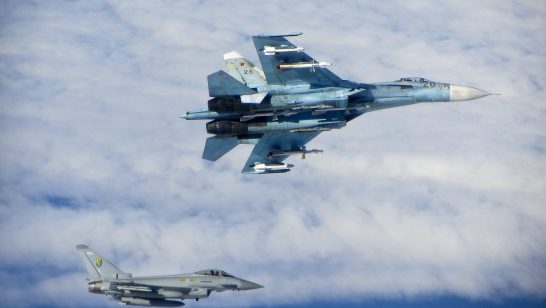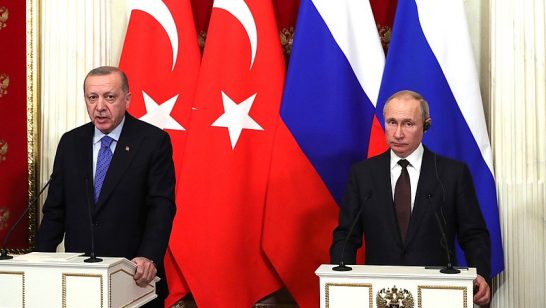
It is not surprising that as a Czech politician, I understand and share many perceptions of NATO-Russia relations with others from the central and eastern European region. The differences among people living in this region rarely concern the substance of the matter but rather reflect a different degree of optimism or skepticism. I admit to being a lifelong cautious optimist, and this approach will be evident in my comments below.
I welcomed President Obama’s Prague vision of a world without nuclear weapons. I welcomed the agreement on and subsequent ratification of the New Start Treaty. And I admit that I was encouraged by the outcome of the NATO Lisbon Summit, because all of this supported the possibility that I would live long enough to see a post-Cold War world with significant reduction of tension, a reduction of the danger that weapons designed never to be used could actually be used, and the emergence of a world where cooperation would clearly prevail over various forms of confrontation.
It also raised a major hope that the billions of dollars earmarked for the maintenance and modernization of nuclear weapons might be used to fight poverty in one part of the world and increase living standards in the other.
Unfortunately, these hopes have run against the wall of reality. The principle of cooperation with Russia is endorsed formally both by the US and by the EU but its concrete forms remain unclear and controversial.
During the Cold War deterrence strategy between the US and Russia was based on approximate strategic parity and MAD (i.e. Mutual Assured Destruction). Post-Cold War, renewed deterrence between the US and Russia is, politically, rather informal by nature compared to the Cold War, but it is still highly institutionalised. One of several pieces of evidence for this can be seen in the interesting exchange between the US and Russia over the Third Site of the US BMD project as it was originally proposed by President George W.Bush. This started with the Russian complaint of the danger posed by the planned missile defence elements in the Czech Republic and Poland for any future required Russian retaliation to a NATO attack. The US reply in turn, assuring Russia that there would be no limitation of its strategic deterrence capability if the Third Site of US BMD was built, encapsulated the embedded logic of deterrence in the relationship.
Moscow has employed a dual rhetoric of threat and cooperation when approaching the relationship with the West on missile defence. The threats have been sometimes abstract, as in warnings against “inevitable arms races” in response to NATO deployment of BMD, and sometime concrete, as in deployment of Iskander missiles in Kaliningrad, targeting Poland and the Czech Republic. The suggested cooperation has consisted of proposals for joint assessments of threat, the presence of experts at each other’s missile defence sites, the offering of faciliteis to host BMD facilities in Russia, or suggestions to keep any BMD system shut down until and unless a credible threat emerges.
At the same time, and even though the New START Treaty was perceived as a success, Russia has registered its unilateral and nonbinding interpretation that New START “may be effective and viable only in conditions where there is no qualitative or quantitative buildup in [US missile defense system capabilities] such that it would give rise to a threat to [Russia’s] strategic nuclear force potential.” Such a buildup, it is argued, would permit, under Article XIV, Russia’s withdrawal from the Treaty. In response to Russia’s statement, the United States issued its own unilateral statement explaining that US missile defences “are not intended to affect the strategic balance with Russia”. The McCain Amendment explicitly declared moreover, that Russia’s statement was not legally binding for the US.
Against the backdrop of these statements, let me illustrate the challenges and opportunities ahead in relation to BMD cooperation. I find the current debate interesting because I remember times when the two sides held opposite views to the ones they express today. The Soviet Union used to boast about its presumed conventional arms strength and the US responded by multiplying U.S. offensive nuclear warheads and developing penetration aids to defeat Moscow’s ABM defences. The danger now is that Moscow will mimic past US behaviour, if not by augmenting the Russian offensive nuclear arsenal, then at least by refusing to negotiate post-New START reductions in strategic offensive arms without securing limits on strategic missile defences.
It has to be acknowledged that a US BMD system with a small number of antiballistic interceptors installed against a rogue state (North Korea, Iran) cannot pose a real threat to Russia. At the same time it is clear that a greater number of such interceptors can be destabilizing for the entire system and may to a certain extent justify Russia’s fears.
The obstacles to any real cooperation on BMD cooperation have become clear rather quickly in this context. There is no mutual understanding on missile threat assessments. Russia takes the position – at least officially – that neither Iran nor any other rogue-state intends to attack Russia, Europe, or the US and its allies in other parts of the world. Moreover, the Russians argue that such states do not possess the necessary missile capabilities to do so. The US and other NATO members on the other hand believe that the rogue-states are in the process of increasing their missile capabilities and are already able to attack states that are neighbours of NATO members as well as other American allies such as Israel, South Korea and Japan, and that in the foreseeable future their capabilities will considerably increase.
A seemingly almost intractable problem is also posed by the different perceptions of the mode of Russian participation that might be possible in relation to NATO BMD. Already at the Lisbon Summit Russian President Medvedev declared that Russian participation in the project should be one of an equal. He said:
“Either we fully take part, exchanging information, taking responsibility for resolving problems or we won’t take part in it at all. In the case that we don’t cooperate then for quite understandable reasons we will be forced to defend ourselves”.
The debate has not been helped by the lack of conceptual consensus over whether BMD should complement NATO’s nuclear deterrence, or should (and indeed could) substitute it. It has taken place against the background of Obama’s vision of the world free of nuclear weapons , while at the same time the new NATO strategic concept proclaims, in a Hobbesian way, that as long as there are nuclear weapons in the world, NATO will remain a nuclear alliance.
Understandably, the US is not prepared to share its technology with the Russians or allow them to participate in NATO decision making. However, it seems that despite the lip service paid towards the principle of multilateralism, in practice the US seem to favour the emergence of a strategic condominium over Europe in which NATO’s allies are duly informed, but have a limited role to play in their own right. Since Russia is not an ally but just a partner and this partnership is still very fragile and unstable, the model of a shared BMD system proposed by Russia seems impossible to realize. Russia’s idea to build a sectoral BMD which would somehow renew its sphere of influence in Eastern Europe also makes such a proposal a non-starter.
Russia covets a stake in the European security architecture, which the U.S. and Europe’s Atlanticists are unwilling to grant it as in their view it would undermine Article 5 of the Washington Treaty. The US Congress is not willing to accept constraints on missile defence capabilities either, and the Russians do not want any significant increase in US strategic missile defence capacity. The issue seems zero-sum. However, each side continues to stress the need for cooperation. In March 2011, White House aide Michael McFaul acknowledged that when he said: “We believe that without some kind of cooperation on missile defence, it will be difficult for us to get on to the other negotiations about reducing strategic nuclear weapons further and non-strategic weapons that are in Europe,”adding that “we hope that at some time this year we have agreement on that.”
I doubt such agreement will come but I do believe that there is an opportunity to achieve BMD cooperation through a series of gradual steps.
Among the first steps must be a number of confidence building measures as I believe that the major obstacle is a lack of trust or rather the existence of major distrust. Such trust can be established through a multitude of contacts and practical cooperation on a wide range of projects. Frequent personal contacts are invaluable. I appreciated, incidentally, the possibility of witnessing friendly exchanges at the ELN-NTI-Hoover Institution conference on deterrence in London in May 2011.
There is no scope here to outline all the necessary individual confidence-building steps but they would need to include transparency measures and the exchange of information about systems. Cooperative early-warning centers would ensure that each side had the best information available, so as to avoid miscalculations and unnecessary responses. Presidents Obama and Medvedev have already agreed to establish a center of this type. A joint intelligence information system, which includes integrated surveillance and analysis could also be considered.
Russia would not through this process gain a voice in the operations of the NATO system, but would benefit if missiles originating in the Middle East were aimed at, or strayed toward, Russian territory and were vulnerable to interceptors on US Aegis warships deployed in the Black Sea. NATO would gain additional confidence that it would have timely warning of potentially hostile missile launches. If Russia will allow the deployment of US warships in the Black Sea it would signify its seriousness about cooperation on missile defence.
However, instead of exploring all such different opportunities for a step by step improvement in the atmosphere we are now apparently witnessing a much tougher stand by Russian leaders. Russia condemned Phase II and III of Obama’s European Phased Adaptive Approach (EPAA) to BMD as these phases, it argued, would enable the deployment of Aegis Ashore in Romania and SM-3 IIA interceptors in Poland. Suddenly Russia also demands – quite nonsensically – some kind pf legal guarantees that this system will not threaten Russia’s national security. This is not conducive to cooperation, and nor are demands for “absolute equality” or for side-by side “sector-based” missile defence systems.
There is no space in this opinion piece for a detailed mention of the US tactical or non-strategic nuclear weapons deployed in Europe. However, it is often acknowledged that these weapons have no military value and now only hold symbolic value. Unfortunately the modernization of the outdated dual capable aircraft intended to carry B61 bombs will be very costly and I doubt that the Europeans will be happy to foot this bill. The presumed deterrent value of the tactical nuclear weapons could possibly be replaced by a BMD system. I understand that many people in central and eastern Europe would like to use these weapons as bargaining chips and obtain some meaningful reciprocity from Russia but Russia continues to be quite intransigent as far as removal of their own non-strategic nuclear weapons is concerned.
In conclusion – let me mention my conviction that the relationship between collective defence and collective security can also be expressed as a relationship between reassurance and reset. The problem is that many people in my region regard reassurance as the necessary precondition for a successful reset of the relations with Russia while Russia perceives some intended methods of reassurance (eg enlargement of the Alliance’s infrastructure or the BMD system) as a threat to its security.
To square this circle we need to continue to talk, to explore all the opportunities to reduce the distrust and seek a compromise that would guarantee security for all without sacrificing the vital interests of any one state or a region.
The opinions articulated above represent the views of the author(s), and do not necessarily reflect the position of the European Leadership Network or any of its members. The ELN’s aim is to encourage debates that will help develop Europe’s capacity to address the pressing foreign, defence, and security challenges of our time.



